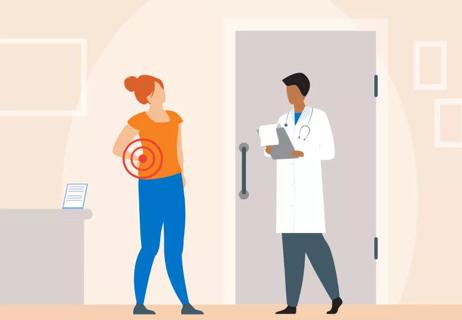Setting the record straight: Diagnosis, treatment + more

Imagine feeling like you have the flu — all the time. Now imagine no one believes you. For people living with fibromyalgia, daily joint pain and body aches are an unfortunate reality. So are the denials from acquaintances and healthcare professionals.
Advertisement
Cleveland Clinic is a non-profit academic medical center. Advertising on our site helps support our mission. We do not endorse non-Cleveland Clinic products or services. Policy
“When you have a broken bone, we can see it on an X-ray. If you have high calcium, we can see it on a blood test. But there isn’t a fibromyalgia test that definitively diagnoses it or rules it out,” explains pain management specialist Robert Bolash, MD.
To set the record straight, Dr. Bolash busts some common fibromyalgia myths.
Fibromyalgia is a real, chronic condition. It is characterized by widespread pain in the muscles, joints and tendons throughout the body. “In patients with fibromyalgia, their pain signals are turned up like you turn up the volume on a radio,” explains Dr. Bolash.
Other fibromyalgia symptoms include:
“Fibromyalgia is a syndrome, and a syndrome is a bunch of different symptoms that fit together. All these symptoms together lead us to a fibromyalgia diagnosis,” notes Dr. Bolash.
While there are no routine scans to diagnose fibromyalgia, the body doesn’t lie. For instance, pain-fighting chemicals inside spinal fluid provide some hard proof. “But we don’t take spinal fluid out of people just to make the diagnosis because that’s a pretty invasive thing to undergo,” relates Dr. Bolash.
Advertisement
“There are also ways to scan the brain to reveal how much sugar it’s using, which looks different in patients with fibromyalgia. But those aren’t things we routinely do in practice.”
Instead, doctors diagnose fibromyalgia by ruling out other conditions and performing a physical exam.
Anyone can diagnose fibromyalgia. (OK, not just anyone.) But your primary care doctor is a great place to start if you suspect you have the condition. Doctors follow this process to get you answers:
“The tender points, or the tender or tense areas, used to be part of the diagnostic requirements for fibromyalgia. But they have really fallen out of favor,” explains Dr. Bolash. “While people can still have tense bands or trigger points, that’s not part of the definition anymore.” In fact, about 20% of people with fibromyalgia will not have them.
Unfortunately, there is no known cause for fibromyalgia. “It may be genetic. It may be environmental. It may be some combination of both,” relates Dr. Bolash.
“In some patients, we do see some inciting events, such as a car accident, a physical trauma or even a psychological trauma. These events can be associated with the start of some fibromyalgia symptoms, but it’s not universal.”
Doctors can prescribe medication to help you manage the condition. While they aren’t a cure-all, they can help you decrease pain and increase sleep. But Dr. Bolash cautions that medications make up only 20 to 30% of the treatment puzzle. The rest involves some key lifestyle modifications.
Dr. Bolash emphasizes there is a lot that patients can do to help themselves. “Most of the treatment doesn’t come in the form of a pill. It comes in modification of activities that the person is doing,” explains Dr. Bolash. That’s why it’s important to come at fibromyalgia management from all angles:
Advertisement
Advertisement
Learn more about our editorial process.
Advertisement

Pain is the distinguishing factor for determining if you have fibromyalgia

This analogy can help you explain the daily struggle of chronic pain

Arthritis, migraines and endometriosis are common causes of chronic pain

Most recommended precautions center around minimizing bruising or swelling

Even one drink can have an impact on your cognitive function leading to slurred speech, blurred vision and impaired memory

Type 2 diabetes isn’t inevitable with these dietary changes

Applying a hot or cold compress can help with pain